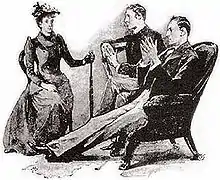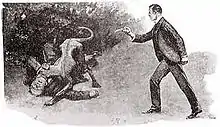| "The Adventure of the Copper Beeches" | |||
|---|---|---|---|
| Short story by Arthur Conan Doyle | |||
 Violet Hunter consulting Holmes, 1892 illustration by Sidney Paget | |||
| Country | United Kingdom | ||
| Language | English | ||
| Genre(s) | Detective fiction short stories | ||
| Publication | |||
| Published in | Strand Magazine | ||
| Publication date | June 1892 | ||
| Chronology | |||
| Series | The Adventures of Sherlock Holmes | ||
| |||
"The Adventure of the Copper Beeches", one of the 56 short Sherlock Holmes stories written by Sir Arthur Conan Doyle, is the last of the twelve collected in The Adventures of Sherlock Holmes. It was first published in The Strand Magazine in June 1892.
Plot summary

Violet Hunter visits Sherlock Holmes for advice on whether she should accept a unique governess job with an initial salary of £100 a year. When she rejected, the employer Jephro Rucastle, increased it to £120 on the condition that she cut her hair short, among other strange provisos. Despite her suspicions, Hunter ultimately agrees and leaves for Hampshire to work at Rucastle's countryside estate, the Copper Beeches, though Holmes recommends she contact him via telegram should she need him.
After a fortnight, Holmes receives a message from Hunter, beseeching him to see her in Winchester. Upon reuniting, she explains that Rucastle would sometimes make her wear an electric blue dress and sit in the front room, with her back to the front window. Suspecting she was not supposed to see something outside, she used a small mirror shard hidden in her handkerchief to confirm and witnessed a man standing by the nearby road looking at the house. Additionally, Rucastle's wife never seemed to smile, Hunter's six-year-old charge was astonishingly cruel to small animals, and her tresses were kept in a locked drawer and switched out for differently coloured yet largely identical versions. Furthermore, a constantly starving Mastiff that only a sour servant and drunkard named Mr. Toller could control was kept on the property and let out at night to prowl the grounds. As such, she was ordered not to cross the threshold after dark.
However, the detail that disturbed her the most was a seemingly unused mystery wing of the house where the windows were either dirty or shuttered. At one point, Rucastle emerged from it, looking perturbed, and claimed he was using it as a darkroom. Unconvinced, Hunter stole Toller's keys and snuck into the mystery wing, only to be spooked by a moving shadow on the other side of a locked door and fled. While Rucastle quickly discovered what she did, he attempted to comfort her instead of reproach her. Recognizing he was overacting and her suspicions were confirmed, she claimed not to have seen anything, which enraged him.
Accepting the case, Holmes discovers someone is being held prisoner in the mystery wing and Rucastle hired Hunter to impersonate his daughter Alice, who Hunter was unaware of and strongly resembled, to convince the stranger outside that Alice is not interested in seeing him. Joined by Hunter and Dr. Watson, Holmes breaks into the mystery wing, but they find it empty. Rucastle, deducing Alice escaped and believing the trio helped her, sets the Mastiff on them. However, it had been starved for longer than usual and attacks him instead until Watson shoots at it with his revolver. Later, Toller's wife confirms Holmes' theory and reveals when Alice came of age, she was to receive an annuity from her late mother's will. Rucastle tried to force her to sign control of the inheritance over to him, resulting in Alice falling ill with brain fever. He subsequently tried to keep her away from her fiancé and hired Hunter to maintain appearances.
Afterward, Alice marries her fiancé; Rucastle survives as an invalid being cared for by his second wife; Hunter becomes the principal of an all-girls' school and meets with "considerable success"; and Watson notes Holmes appears to have been drawn to Hunter, though Holmes says otherwise.
Publication history
"The Adventure of the Copper Beeches" was first published in the UK in The Strand Magazine in June 1892, and in the United States in the US edition of the Strand in July 1892.[1] The story was published with nine illustrations by Sidney Paget in The Strand Magazine.[2] It was included in the short story collection The Adventures of Sherlock Holmes,[2] which was published in October 1892.[3]
Adaptations
Film and television
The story was adapted as the short film The Copper Beeches (1912), starring Georges Tréville and directed, though uncredited, by Adrien Caillard, as part of the Éclair film series.[4] The Copper Beeches (1912) was one of a series of eight silent film adaptations of the Holmes stories that were actually supervised by Conan Doyle. It is the only one that has survived. It is altered in several respects. Instead of beginning with Ms Hunter's visit to Baker Street to tell her story, it starts with Rucastle trying to force his daughter to sign away her rights to her fortune, and then ordering her fiancé off his property. Rucastle subsequently locks up his daughter. The film only has Holmes (no Watson), and there is no appearance of Mrs Rucastle nor the servants. Nor is there any mastiff hound. The scheme of why Rucastle wants Ms Hunter to trim her hair and stand by the window is the same, but the motive is different: Rucastle seeking to lure the fiancé back so he can pretend he shot him as a trespasser. In the end Holmes and the police capture Rucastle, and the daughter and her fiancé are united.
Another short film adaptation, The Copper Beeches (1921), was released as part of the Stoll film series starring Eille Norwood.[5]
The story was adapted as "The Copper Beeches", a 1965 episode of Sherlock Holmes starring Douglas Wilmer as Holmes, Nigel Stock as Watson, Suzanne Neve as Violet Hunter and Patrick Wymark as Jephro Rucastle.[6]
"The Copper Beeches" is a 1985 episode of The Adventures of Sherlock Holmes starring Jeremy Brett as Sherlock Holmes, with Natasha Richardson as Miss Hunter and Joss Ackland as Rucastle.[7]
Radio
"The Copper Beeches" was adapted by Edith Meiser as an episode of the radio series The Adventures of Sherlock Holmes. The episode aired on 17 November 1930, with Richard Gordon as Sherlock Holmes and Leigh Lovell as Dr. Watson.[8] Another radio dramatisation of the story aired on 5 May 1935 (with Louis Hector as Holmes and Lovell as Watson).[9] Meiser also adapted the story as an episode of The New Adventures of Sherlock Holmes with Basil Rathbone as Holmes and Nigel Bruce as Watson. The episode aired on 6 October 1940.[10] Other dramatisations of the story aired on 7 May 1943 (again with Rathbone and Bruce) and in November 1947 (with John Stanley as Holmes and Alfred Shirley as Watson).[11]
The story was adapted by Felix Felton as a radio production that aired on the BBC Light Programme in 1955, as part of the 1952–1969 radio series starring Carleton Hobbs as Holmes and Norman Shelley as Watson.[12]
An adaptation aired on BBC radio in 1978, starring Barry Foster as Holmes and David Buck as Watson. It was adapted by Michael Bakewell.[7]
"The Copper Beeches" was dramatised by Peter Mackie for BBC Radio 4 in 1991 as an episode of the 1989–1998 radio series starring Clive Merrison as Holmes and Michael Williams as Watson. It featured Roger Hammond as Jephro Rucastle and Imogen Stubbs as Violet Hunter.[13]
The story was adapted as a 2015 episode of the radio series The Classic Adventures of Sherlock Holmes, with John Patrick Lowrie as Holmes and Lawrence Albert as Watson.[14]
Peter Cannon has pointed to parallels between "The Adventure of the Copper Beeches" and H. P. Lovecraft's story "The Picture in the House".[15]
In Sherlock Holmes's War of the Worlds, Violet Hunter becomes the second wife of Dr. Watson mentioned in "The Adventure of the Blanched Soldier". Hunter was said to have been married to the first mate on HMS Thunder Child.
References
- Notes
- ↑ Smith (2014), p. 67.
- 1 2 Cawthorne (2011), p. 72.
- ↑ Cawthorne (2011), p. 54.
- ↑ Eyles, Allen (1986). Sherlock Holmes: A Centenary Celebration. Harper & Row. p. 130. ISBN 9780060156206.
- ↑ Eyles, Allen (1986). Sherlock Holmes: A Centenary Celebration. Harper & Row. p. 131. ISBN 9780060156206.
- ↑ Eyles, Allen (1986). Sherlock Holmes: A Centenary Celebration. Harper & Row. p. 138. ISBN 9780060156206.
- 1 2 Eyles, Allen (1986). Sherlock Holmes: A Centenary Celebration. Harper & Row. p. 140. ISBN 9780060156206.
- ↑ Dickerson (2019), p. 25.
- ↑ Dickerson (2019), p. 64.
- ↑ Dickerson (2019), p. 95.
- ↑ Dickerson (2019), p. 240.
- ↑ De Waal, Ronald Burt (1974). The World Bibliography of Sherlock Holmes. Bramhall House. p. 385. ISBN 0-517-217597.
- ↑ Bert Coules. "The Adventures of Sherlock Holmes". The BBC complete audio Sherlock Holmes. Retrieved 12 December 2016.
- ↑ Wright, Stewart (30 April 2019). "The Classic Adventures of Sherlock Holmes: Broadcast Log" (PDF). Old-Time Radio. Retrieved 14 June 2020.
- ↑ Peter Cannon, Lovecraft Studies No. 1 (Fall 1979); cited in Joshi and Schultz, p. 207.
- Sources
- Cawthorne, Nigel (2011). A Brief History of Sherlock Holmes. Running Press. ISBN 978-0762444083.
- Dickerson, Ian (2019). Sherlock Holmes and His Adventures on American Radio. BearManor Media. ISBN 978-1629335087.
- Smith, Daniel (2014) [2009]. The Sherlock Holmes Companion: An Elementary Guide (Updated ed.). Aurum Press. ISBN 978-1-78131-404-3.
External links
 The full text of The Adventure of the Copper Beeches at Wikisource
The full text of The Adventure of the Copper Beeches at Wikisource Media related to The Copper Beeches at Wikimedia Commons
Media related to The Copper Beeches at Wikimedia Commons- The Adventures of Sherlock Holmes, including The Adventure of the Copper Beeches at Standard Ebooks